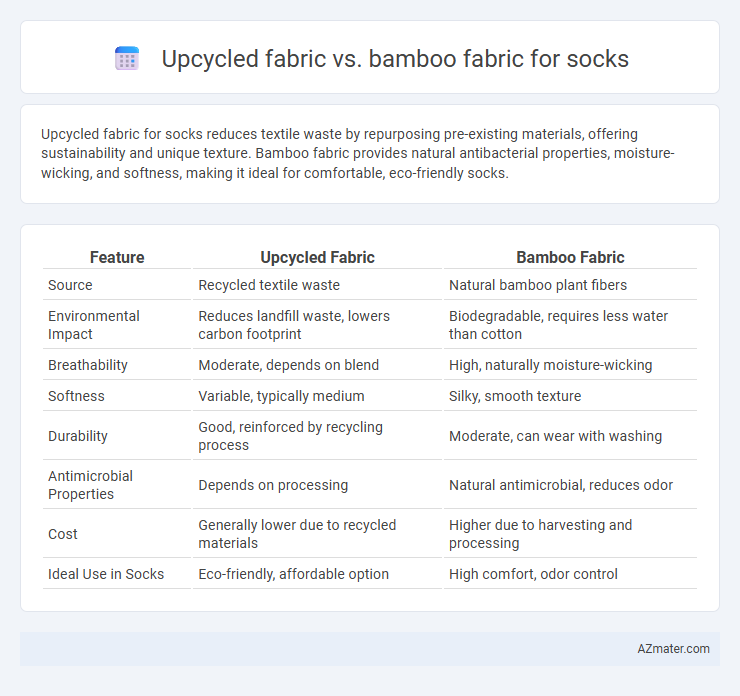Upcycled fabric for socks reduces textile waste by repurposing pre-existing materials, offering sustainability and unique texture. Bamboo fabric provides natural antibacterial properties, moisture-wicking, and softness, making it ideal for comfortable, eco-friendly socks.
Table of Comparison
| Feature | Upcycled Fabric | Bamboo Fabric |
|---|---|---|
| Source | Recycled textile waste | Natural bamboo plant fibers |
| Environmental Impact | Reduces landfill waste, lowers carbon footprint | Biodegradable, requires less water than cotton |
| Breathability | Moderate, depends on blend | High, naturally moisture-wicking |
| Softness | Variable, typically medium | Silky, smooth texture |
| Durability | Good, reinforced by recycling process | Moderate, can wear with washing |
| Antimicrobial Properties | Depends on processing | Natural antimicrobial, reduces odor |
| Cost | Generally lower due to recycled materials | Higher due to harvesting and processing |
| Ideal Use in Socks | Eco-friendly, affordable option | High comfort, odor control |
Introduction to Sustainable Sock Materials
Upcycled fabric and bamboo fabric represent two innovative sustainable materials transforming the sock industry by reducing environmental impact and promoting eco-friendly practices. Upcycled fabric involves repurposing textile waste into new sock products, significantly minimizing landfill contributions and conserving resources. Bamboo fabric, derived from rapidly renewable bamboo plants, offers natural antimicrobial properties and biodegradability, making it a popular choice for sustainable sock production.
What is Upcycled Fabric?
Upcycled fabric is material repurposed from discarded textiles, reducing waste and environmental impact by transforming old garments or fabric scraps into new products such as socks. Compared to bamboo fabric, which is derived from bamboo pulp and known for its softness and antibacterial properties, upcycled fabric emphasizes sustainability through the reuse of pre-existing materials rather than cultivation. Choosing upcycled fabric for socks supports circular fashion by minimizing resource consumption and landfill contributions.
What is Bamboo Fabric?
Bamboo fabric is a sustainable textile made from the pulp of bamboo grass, known for its softness, breathability, and natural antibacterial properties, making it ideal for socks. It offers excellent moisture-wicking capabilities and UV protection, enhancing comfort and hygiene during wear. Compared to upcycled fabric, bamboo fabric provides a renewable and biodegradable option with superior thermal regulation and durability.
Environmental Impact Comparison
Upcycled fabric for socks significantly reduces textile waste by repurposing discarded materials, lowering landfill contributions and minimizing the need for virgin fiber production. Bamboo fabric, while biodegradable and fast-growing, involves water-intensive processing and chemical treatments that can offset some environmental benefits. Choosing upcycled fabric socks supports circular economy practices with a smaller overall carbon footprint compared to bamboo alternatives.
Comfort and Breathability Factors
Upcycled fabric socks often incorporate recycled cotton or polyester, providing moderate comfort and breathability due to their mixed fiber content, which balances durability with softness. Bamboo fabric socks excel in moisture-wicking and natural breathability, thanks to bamboo's micro-gaps and soft cellulose structure that enhance airflow and temperature regulation. Bamboo fibers tend to outperform upcycled fabrics in comfort for sensitive skin, offering superior softness and antimicrobial properties ideal for prolonged sock wear.
Durability and Longevity
Upcycled fabric socks offer enhanced durability by incorporating materials like recycled cotton and polyester, which resist wear and tear while reducing environmental impact. Bamboo fabric socks provide natural antimicrobial properties and softness but may show signs of thinning faster due to bamboo's plant-based fibers. For long-lasting performance, upcycled fabric typically outperforms bamboo fabric in maintaining structural integrity after repeated washes and extended use.
Cost and Accessibility
Upcycled fabric for socks generally offers a lower cost due to utilizing reclaimed materials and reducing waste, making it an economical choice for budget-conscious consumers. Bamboo fabric, while slightly more expensive, provides benefits such as natural antibacterial properties and superior softness, though it may be less widely available in mainstream markets compared to upcycled options. Both fabrics support sustainable fashion, but upcycled fabric tends to be more accessible through niche eco-friendly brands, whereas bamboo fabric is commonly found in specialized stores and online retailers.
Style and Aesthetic Options
Upcycled fabric socks offer unique, one-of-a-kind patterns and eco-friendly appeal, making each pair a stylish statement piece that emphasizes sustainability through distinctive textures and color variations. Bamboo fabric socks provide a sleek, smooth finish with a natural sheen, available in a consistent range of soft pastel and neutral tones that suit minimalist and modern fashion sensibilities. Both fabrics allow designers to create versatile sock styles, but upcycled materials excel in bold, artistic aesthetics while bamboo excels in refined, breathable comfort.
Consumer Preferences and Trends
Consumers increasingly favor upcycled fabric socks for their eco-conscious appeal and reduced environmental footprint, aligning with growing sustainability trends. Bamboo fabric socks attract buyers due to their natural antibacterial properties, softness, and moisture-wicking capabilities, which enhance comfort and hygiene. Market data highlights a rising demand for both materials, driven by eco-friendly awareness and performance benefits in the footwear industry.
Final Verdict: Choosing the Best Sustainable Sock Fabric
Upcycled fabric socks excel in reducing textile waste by repurposing discarded materials, offering strong durability and unique patterns that appeal to eco-conscious consumers. Bamboo fabric socks provide exceptional softness, natural moisture-wicking, and antimicrobial properties, making them ideal for all-day comfort and hygiene. Choosing the best sustainable sock fabric depends on prioritizing waste reduction and uniqueness with upcycled fibers or enhanced comfort and breathability with bamboo.

Infographic: Upcycled fabric vs Bamboo fabric for Sock
 azmater.com
azmater.com